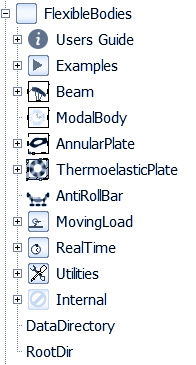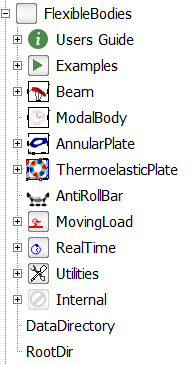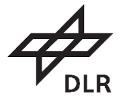DLR FlexibleBodies LIBRARY
The commercial DLR FlexibleBodies Library enables the object-oriented and mathematically efficient modelling of flexible bodies as components of multibody and of arbitrary physical systems. It provides Modelica model classes to model beams, annular plates, anti-roll bars and general flexible bodies exported from finite element programs. The motion of a flexible structure is defined by superposition of a in general large, non-linear motion of a reference frame with small elastic deformations. The library is commercially available at LTX and Dassault Systems.
FEATURES OF THE LIBRARY
- Considers bending deformation in two planes, St-Venant torsion and lengthening displacements.
- Analytical eigenmodes are used to discretize the elastic deformation field.
- The beam is assumed to be straight with a constant cross section along its longitudinal axis.
- Only homogeneous and isotropic elastic material properties are considered.

- Geometric stiffening (or softening) effects such as the influence of large longitudinal forces on the bending behavior are taken into account
- Describes the mechanical behaviour of an annular plate, presented as a homogeneous Kirchhoff plate with transverse deformations.
- Eigenmodes are used to discretize the deformation field.
- With respect to the rotations around the angular plate axis, loads may be applied to structure-fixed Lagrange nodes that follow this rotation and therefore may also be called rotate-with-plate nodes. .
- Alternatively, space-fixed Arbitrary-Lagrangian-Eulerian (ALE) or slide-on-plate nodes are available.

- A ModalBody instance is capable to represent bodies with an arbitrary geometrical shape that originate from finite element data.
- The library exploits the so-called SID format or file, respectively, in order to represent the mechanical properties of the structure under consideration and uses a wavefront file for visualization and animation purposes.
- These files have to be generated in a preprocessing step from finite element data of the body. We recommend to use interfaces from Abaqus or Simpack.

- The AntiRollBar model allows for the modeling of automotive anti-roll bars (also called stabilizer or anti-sway bar) with an (almost) arbitrary geometrical shape in a user-friendly way.
- Considers attachments to the vehicle body and the suspensions.
- Tailored to be used for vehicle driving maneuvers or to be employed for NVH analysis as well.

APPLICATION EXAMPLES
Control of a Helicopter Rotor
Automotive Suspension
Star Shape
Control of a Helicopter Rotor
| The swash plate of a helicopter rotor, here modeled as an annular plate, supports two linkages that actuate the pitch joint of the helicopter blades. This mechanism is controlled by the tilting angle of the swash plate. And in turn, the motion of the helicopter fuselage can be controlled this way, since the direction and value of the air forces acting on the blades depend on their pitch angle. The deformations of the rotor blades and the flexibility of the swash plate influence the accuracy and the performance of the rotor system. |
Control of a Helicopter Rotor |
Automotive Suspension
| The DLR ROboMObil is a robotic electro-mobility concept based on intelligent central control of four wheel robots, which integrate the drivetrain, brakes, steering and dampers in the wheel vicinity. In the design and lay-out phase, a detailed study on the mechanical behaviour of this new suspension with integrated steering mechanism has been conducted. The assessment included i.a. the consideration of the elastic deformation of the suspension arms on rough roads scenarios. |
Automotive Suspension |
Star Shape
| In this example the structural dynamics of the fun ride „Star Shape“ has been evaluated in a joint project between SCIL and the companies Zierer / Streicher. The resulting model has been used to derive optimal, passenger-weight independent trajectories and to assure whether the available motor power is sufficient. Furthermore the resulting accelerations on the passengers have been calculated. |
StarShape |



